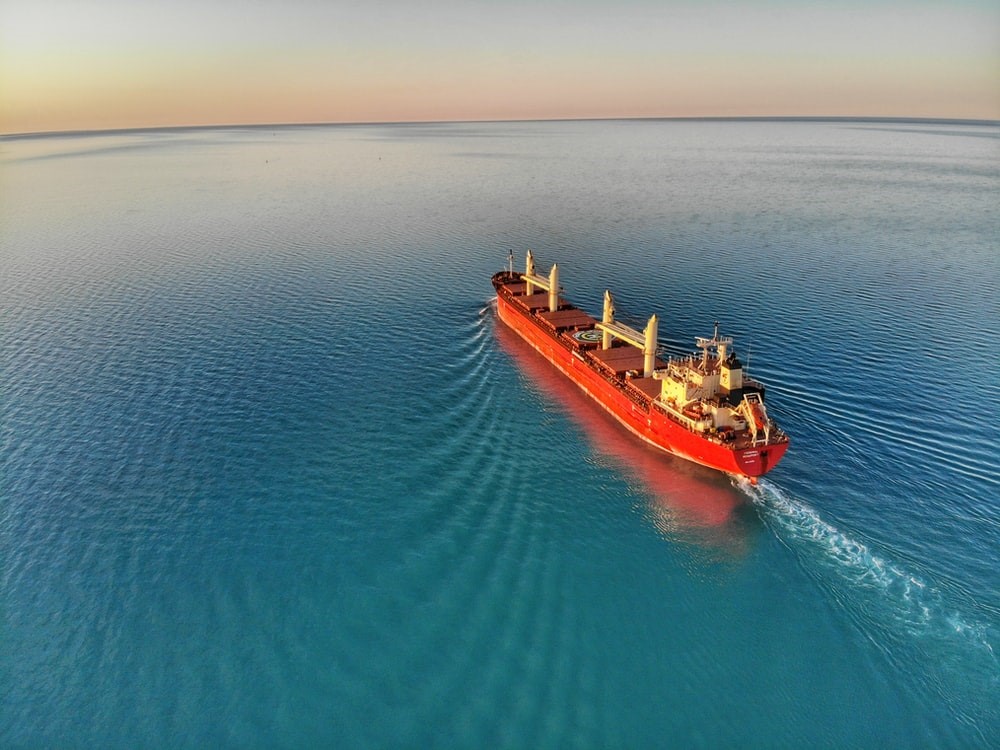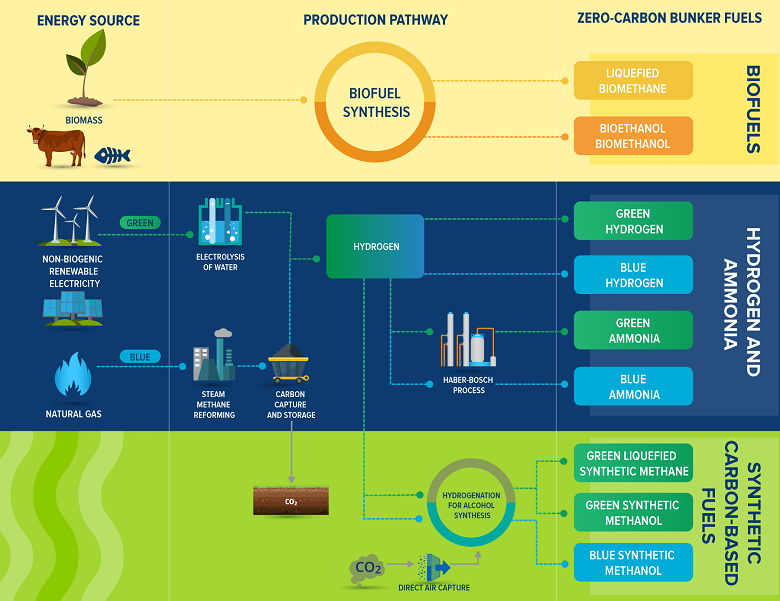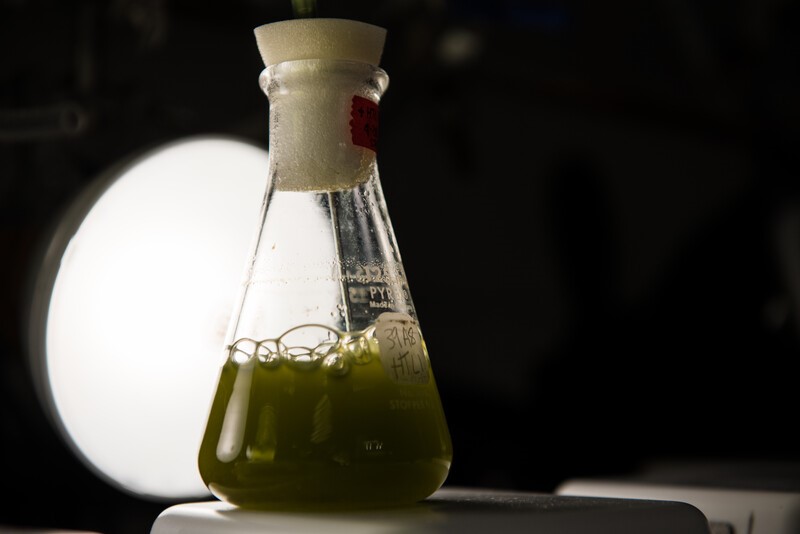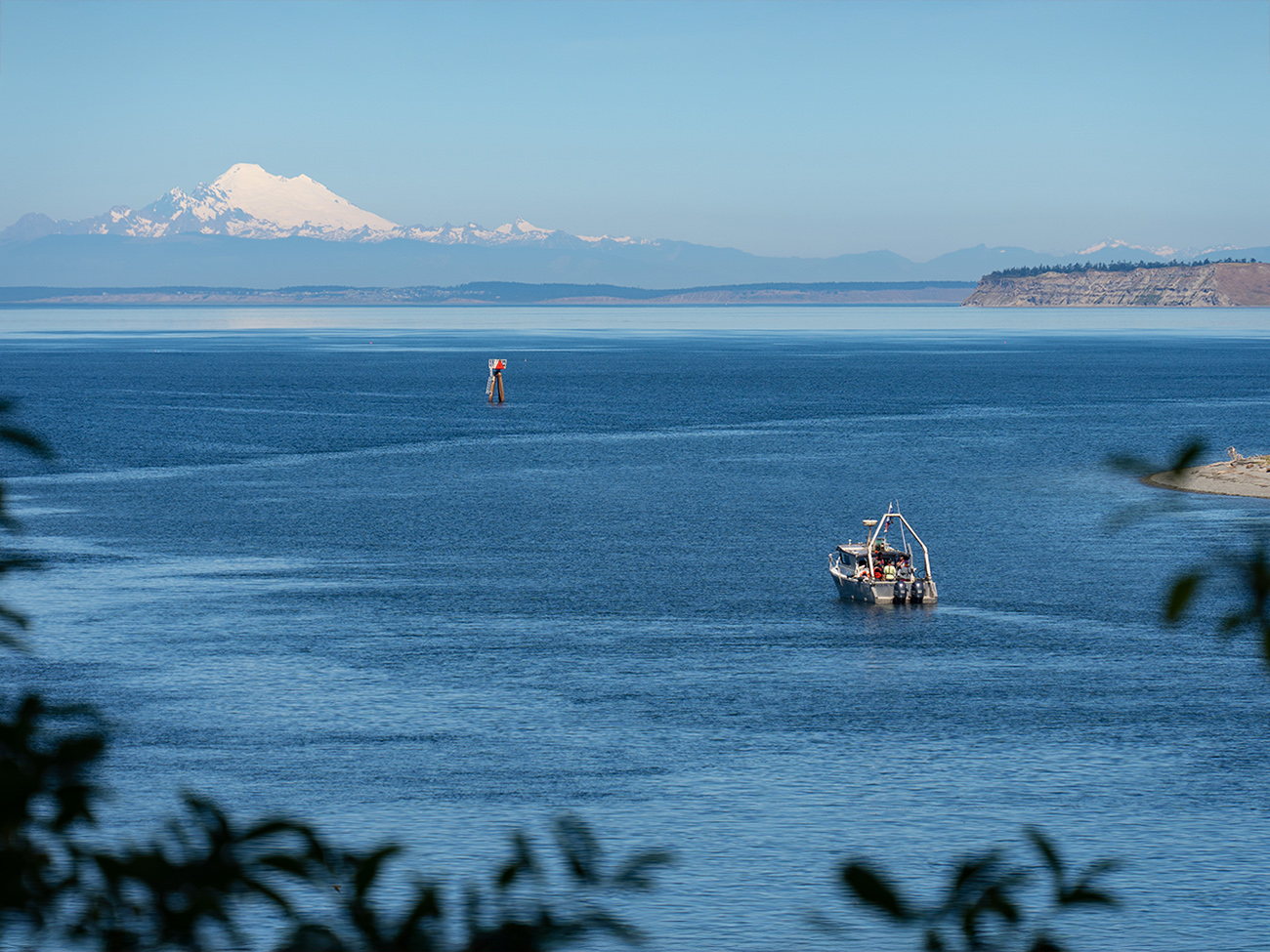Maritime Decarbonization
What is maritime decarbonization?
As global temperatures continue to rise due to increased concentrations of greenhouse gases (GHGs), various sectors and industries are pulling together to rethink business-as-usual. One crucial strategy among them you may have heard about: decarbonization.
Decarbonization is the process of reducing carbon dioxide (CO2) emissions to achieve a lower output of GHGs into the atmosphere. It involves the adoption of sustainable low-carbon power and fuel sources. Numerous sectors are grappling with how to decarbonize quickly and the maritime industry is no exception. With such a foundational role in global trade and supply chains, maritime decarbonization is critical to decarbonizing the global economy as a whole.
Annually, large transport and cargo ships transport $4 trillion worth of goods across our seas—everything from food and clothing to building supplies, medicine, and more. Mammoth container ships can stretch the length of five city blocks and carry more than 20,000 containers each. Collectively, they transport approximately 80% of global trade by volume.
Along the way, these ships emit more than one billion tons of GHG emissions into the atmosphere, or nearly 3% of emissions worldwide. Under business-as-usual scenarios, emissions are expected to rise through the next several decades.
In 2018, the International Maritime Organization (IMO), an international agency responsible for regulating shipping, set an ambitious goal—to cut GHG emissions by at least 50% by the year 2050, relative to a 2008 baseline. Hitting this target will require a shift away from the petroleum-based fuels like diesel and heavy fuel oil that are the industry standard today. New fuels and energy efficiency measures must be adopted. Swift action and coordination among multiple stakeholders across the maritime industry, government, and research and academic institutions is required to successfully navigate this one-in-a-century energy transition.

History of maritime decarbonization
The challenge ahead for the shipping industry may seem formidable now, but history is riddled with examples of how the maritime industry has navigated major transitional periods of the past.
Cargo ships harvested wind energy to power their sails until about the 19th century, when they began to be replaced by faster steamships. The next major transition wasn’t until the latter half of the second century when motor ships using internal combustion engines became the predominant commercial vessels of choice. Ironically, it was around this same time that scientists began sounding the alarm about the increasing evidence of the warming effect of GHGs in the atmosphere.
Heavy fuel oil has been the dominant fuel in the industry since the 1960s due to its low cost, energy density, and widespread availability. This thick, tar-like substance is a residual fuel that is left over from refinement of other lighter distillate fuels and often contains heavy metals and other compounds that lead to harmful air pollution when used for combustion. Heavy fuel oil’s dominance in the maritime industry may be starting to wan, however. Industry regulators and ship operators are beginning to recognize the only viable future is one in which low-carbon fuels are the dominant choice. Alternative fuels are just one of several pathways for maritime decarbonization—other possible pathways include electrification and energy efficiency. Each will have a role to play in the maritime energy transition.
Why does maritime decarbonization matter?
Decarbonizing the maritime industry is necessary for our planet and human health, and would even benefit our global economy. Some of the most obvious advantages of a greener maritime future include the following.
- Cleaner air: Cargo ships that use heavy oil fuel emit sulfur dioxide as a byproduct, a toxic pollutant linked to acid rain, respiratory illness, and premature morbidity and mortality rates. That’s in addition to the carbon dioxide and methane they exhale, gases which trap heat in the atmosphere and accelerate the impacts of climate change. Transitioning to cleaner fuels could significantly reduce air pollution caused from maritime transportation overall.
- Cleaner water: To meet international regulations around allowable sulfur content, some ship owners have opted to install exhaust gas cleaning systems, or scrubbers, that remove excess sulfur oxides (SOx) from the exhaust gas before releasing it into the atmosphere. These exhaust gas cleaning systems often use seawater to remove sulfur which is discharged back into the ocean, leading to pollution in marine environments. Nitrogen oxide (NOx) is another known pollutant emitted by ships that’s responsible for toxic algal blooms in coastal waters and inland lakes. Scrubber discharge water and NOx pollution could both be reduced or eliminated entirely with the use of cleaner alternative fuels.
- Economic development: Many developing countries boast large renewable energy resources representing an estimated $1 trillion future fuel market that is still largely untapped. This represents an immense opportunity to bolster these countries’ industrial infrastructure and modernize their energy systems while significantly lowering the environmental impacts of our transportation systems worldwide.
Left unchecked, the IMO estimates that maritime emissions will grow to between 90% and 130% of 2008 levels by 2050. Changing now could help mitigate some of the more disastrous effects of continuing to rely on heavy oil fuel while providing a boost to the global economy.
Approaches to maritime decarbonization
While energy efficiency is certainly important when designing vessels of the future, fully decarbonizing will depend on developing new fuel pathways, as well. A few potential solutions represent the most feasible and promising path forward.
Electrification
There are various ways to electrify vessel operations. Diesel-electric engines, electric generators, and large motors have all been used for decades. Plug-in hybrids that use a combination of batteries, engines, and electric motors are gaining popularity for use in cars, as well as ships. Finally, all-electric ships rely entirely on batteries and motors to power the vessel over the course of its journey, stopping to recharge at ports when needed.
Potential: Electrified vessels save fuel, and electricity is much cheaper than oil, leading analysts to predict that sales of fully electric and hybrid ships will increase in the next several decades.
Limitations: Right now, electrification is a viable option for shorter voyages only, but batteries are still not efficient enough or light enough for ships that must sail long distances. Additionally, ports still need suitable charging infrastructure put in place.
Hydrogen-based fuels
Hydrogen can be produced through water electrolysis, ideally using renewable energy, or through steam methane reforming of natural gas (the most common method used today). Hydrogen can be further processed along with nitrogen to synthesize ammonia into another potential fuel.
Potential: Often cited as one of the most promising solutions for shipping companies looking to meet the IMO target, these fuels are clean, scalable, and potentially cost-effective.
Limitations: The primary limitations to incorporating these fuels are cost, availability, and safety concerns. Fuel cell systems for ships are under development and will take some time to reach a level of maturity necessary to replace main engines. Fuel producers also need to see legitimate demand before investing in widescale production. Additionally, the price of electrolysis can be quite expensive and so can installing enough fuel cells to power a ship. Last, safety concerns will need to be addressed regarding handling combustible hydrogen on docks or aboard vessels.
Biofuels
Derived from biogenic feedstock such as plants, agricultural waste, municipal solid waste, or algae, biofuels include a variety of fuels and fuel blends including hydrogenated vegetable oil, straight vegetable oil, biomethanol, biodiesel, and more. They do emit CO2 when burned in an internal combustion engine, but some also extract CO2 from the atmosphere during their production. They are biodegradable and sulfur free, and many are labeled as net-zero.
Potential: Some marine-grade biofuels can be used as drop-in replacements for more traditional fuels used in conventional internal combustion engines. Various grades and blends of biofuels could be combined and used in engines already certified for operation with biodiesel or biodiesel blends. This would save on the costs of retrofitting and could be a huge step toward a cleaner maritime future.
Limitations: There is still a glaring need to scale production and develop biofuel supply chains to be viable for widescale adoption. Additionally, biofuels are more expensive than fossil fuels and likely to remain so until widespread adoption, environmental regulation, and/or consumer demand drive costs down.
Liquified natural gas (LNG)
Natural gas occurs naturally or can be produced through a variety of production pathways. It is predominantly composed of methane, a potent GHG. When natural gas is cooled to cryogenic temperatures, it changes from a gas to a liquid, making it more practical to store and transport in large volumes.
Potential: LNG is both abundant and relatively affordable. Additionally, it is significantly less toxic than diesel and can be used in hybrid vessels.
Limitations: Unfortunately, despite its potential, its primary component is methane, which is approximately 30 times more potent at trapping heat in the atmosphere than carbon dioxide. Thus, while it can offer temporary solutions during the energy transition, it is considered by most to not be viable in the long-term solution.
Long-term change won’t happen overnight, but with continued investment and the help of early adopters, it’s possible that within a decade or two the maritime industry could be powered primarily through a mix of hydrogen-based fuels, biofuels, and batteries charged with renewable energy.
Barriers to Maritime Decarbonization
Despite widespread agreement on the need to decarbonize, three main barriers still stand in the way of keeping pace with the desired IMO timeline.
- Regulatory uncertainty: Emissions reduction regulations and incentives are currently inconsistent across states, regions, or countries. Without clear and consistent regulations in place, the private sector faces uncertainty and little incentive to make sweeping and costly changes to their operations.
- Availability and affordability of zero-carbon fuel and vessels: Zero-carbon fuels and technologies currently aren’t available at the size, scale, or price the shipping industry needs for widescale adoption. Manufacturers need a certain level of demand from major shippers to make large-scale manufacture economically viable. But ship owners can’t commit to alternative fuels until there is sufficient production to meet demand.
- Slow to innovate: The maritime value chain is long and includes stakeholders such as ship owners and operators, port owners, terminal operators, ship chandlers, fuel providers, regulators, and more. This fragmentation slows the rate of adoption for new fuels and technologies.
These challenges are not insurmountable. As confidence in the feasibility of different technologies being used in real-world operations grows, it will help lay the groundwork for deployment at scale.

Innovations in maritime decarbonization
To meet the IMO’s goals, commercially viable, zero-emissions vessels must start entering the global fleet by the 2030s and be radically scaled throughout the 2030s and 2040s. Already, we’re beginning to see some hints of what the future of shipping may have in store. Norway has already electrified portions of its ferry fleet and even demonstrated electrification of its cargo vessels, for instance. Across the globe, ports are moving toward a zero-emission operational water front. In the Pacific Northwest, Washington State has plans to electrify its ferry fleet and the NW Seaport Alliance has established goals to become carbon neutral by 2030.
Getting Shipping Giants on Board
In March 2021, Maersk, the world’s biggest shipping company, pledged to launch the first carbon-neutral vessel by 2023 and have stated it will launch its first zero-carbon emissions vessel by 2030. Already, they have invested an impressive $1.4 billion in ships run on carbon-neutral methanol and have ordered approximately 10 ships capable of running on e-methanol.
Another international shipping company, Compagnie Maritime Belge, made headlines in 2017 when it launched the Hydroville, the first sea vessel to burn hydrogen in a diesel engine. Since then, they have continued to position themselves as early adopters by introducing several other hydrogen-powered boats and even building their own maritime refueling station for hydrogen cars, buses, and ships, including an electrolyzer that can produce its own hydrogen, in the Antwerp port.
Harnessing Wind and Waves
Teams of researchers are also exploring how the air and water we’re trying to protect could potentially become a solution. In Costa Rica, a team is building the world’s largest clean cargo ship, called Ceiba. Ceiba will be powered by a combination of masts that capture the energy of the wind, solar panels that capture the energy of the sun, underwater turbines, and a uniquely designed electric engine and batteries. When traveling, Ceiba will rely on sails and underwater turbines designed to capture excess energy. The electricity, along with power generated by the solar panels, will be stored in a battery that can be used to drive the ship. The regenerative engine is entirely electric and doesn’t use diesel as a backup.
In the Philippines, a hybrid trimaran is using a wave energy converter that turns kinetic energy into electricity that cuts down on diesel fuel. In an article on the ship published by the BBC, Rob Cavagnaro, a mechanical engineer at Pacific Northwest National Laboratory in Sequim, WA, was asked to comment on the project as a subject matter expert. While the trimaran is still a prototype at this point, it could pave the way for subsequent versions that use wave energy to help ships' engines generate more power or even fuel vessels entirely.
Collaborative research in maritime decarbonization at PNNL
Of course, the maritime industry is more than just ships and fuel. More broadly, it represents the vast international networks of ports, distributors, shippers, regulators, researchers, technology developers, and local communities that make the global economy turn. A transition of this magnitude requires a massive, coordinated effort from all involved.
As an essential conduit in our innovation ecosystem, national laboratories are uniquely positioned to help make the connections that drive technological development and deployment, environmental justice initiatives, and place-based innovation forward.
Partnerships
- Created by the Department of Energy's (DOE’s) Water Power Technologies Office, the Powering the Blue Economy Initiative is designed to accelerate growth in the blue economy by leveraging the power and promise of the oceans to meet the power requirements of maritime markets. In the blue economy, marine transportation is a fundamental sector that other sectors rely on.
- Washington Maritime BLUE is a unique public/private alliance that brings together various maritime stakeholders—industry, government, Tribes, research universities, and nongovernmental organizations—to advance the common goal of creating a future where economic development, thriving coastal communities, and healthy ecosystems are interdependent. Drawing on the expertise of related but separate industries and the rich economic and natural ecosystems of Washington State, they are exploring novel methods of deriving hydrogen from renewable resources and working with local ports to support updated infrastructure to accommodate a shift toward electrification and cleaner operations. Their goal is to make Washington State home to the most sustainable maritime industry in the world by 2050.
- Separately, Pacific Northwest National Laboratory (PNNL) is working with regional and state partners such as the Port of Seattle, Port of Tacoma, Port of Port Angeles, Seattle City Light, and others to determine how to integrate cutting-edge sustainable energy technologies into existing operations and whether ports will need updated infrastructure to support new electrical loads. These collaborations will be especially relevant as Washington State ferries, the second largest fleet in the world and the single largest state government user of diesel fuel, works toward a fully hybridized fleet by 2040.
Research Highlights
Ports are beginning to diversify their energy sources and become electricity producers rather than just consumers of a single energy source, and there are several PNNL projects that could help speed this transition.
- Offshore wind turbines could support maritime electrification in addition to allowing ports to produce their own hydrogen through water electrolysis, potentially using seawater.
- Wave energy also holds promise to help separate oxygen and hydrogen through technologies such as wave energy converters so hydrogen can be used as an energy source. Researchers at PNNL-Sequim are exploring these areas and more to learn how to harness renewable fuel from the ocean.
- Funding from DOE’s Office of Electricity is allowing PNNL researchers to advance the development and deployment of microgrids, relatively small electrical networks that include power generation and storage assets that provide continued access to power even when the electrical grid is down. They can bolster port energy resilience and security, assuring that the port’s critical infrastructure can operate during emergencies. It also helps with managing increased electrical loads due to vessel charging or cold ironing vessels, which is the process of connecting shoreside electrical power to a ship when its engines are turned off.
- DOE’s Hydrogen and Fuel Cell Technologies Office manages PNNL’s fuel cell research, which is currently investigating new ways to produce and store hydrogen while lowering capital costs. In addition, PNNL continues to be a national leader in fuel cell and electrolyzer technologies.
- A world leader in catalysis sciences, PNNL is leveraging its multidisciplinary expertise to advance biofuel research in addition to forming partnerships with other national labs and industry to boost production capabilities.
- PNNL’s research on lighter materials, waste heat recovery systems, and the prevention of biofouling (an undesirable accumulation of biofilms that can impede fuel efficiency) could all speed up the design, development, and deployment of more energy-efficient ships.
For researchers looking to collaborate, both Tethys and Tethys Engineering are virtual collaboration spaces that include access to databases and knowledge hubs related to marine energy.

